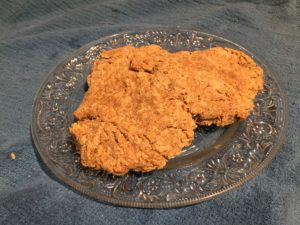Adventures in the Kitchen: Viking Bread
Somehow, on my travels around the internet, I landed on this page at The Dockyards, a Viking history site, which led me to this video on baking Viking bread from Archeosoup Productions.
I am fortunate to live in the land of Organic Grocery Stores Which Carry Non-Standard Grains, so I picked up the necessary ingredients last week, with the idea that I would make this bread on the weekend. Saturday, we had a heat wave (89 degrees Fahrenheit! ick!) (look, I know that’s not especially hot for a lot of you, but for those of us who live in a place where the average temperature is 68 degrees, 89 is hellish).
Anyway, it finally cooled off enough in the evening that the idea of turning on the oven wasn’t completely horrifying, so I gave it a whirl. And this was my result!

Viking Bread!
The recipe actually made six rounds, but I ate three of them before I remembered to take the photo. Oops!
The texture is crumbly, but since there’s no binder (egg, etc.) that’s to be expected. The barley and flax flavors are quite pronounced, so if you don’t care for either of those flavors, you can substitute another kind of flour in place of some or all of the barley flour, and/or omit the flax seeds.
I tried different toppings with it: butter, honey, butter and honey, almond butter, cashew butter, and Brie cheese. The cashew butter was terrific with it, but then again, I really like cashew butter on pretty much any bread-like substance. The butter and honey were quite good, and historically feasible. The Brie didn’t work as well; I want to try this again with both a milder cheese and a really intense cheese.
I agree with the video hosts—this is much better eaten warm than cold. It reheated fine in the toaster as well the next day.
I adapted the recipe a bit, and here’s what I came up with:
Viking Bread
The recipe is based on an analysis of Viking Age bread, found in Birka, Sweden, put together by the lovely folks at Archeosoup Productions and The Dockyards, and adapted by Anastasia Haysler.
About 150 g barley flour (6 ounces)
About 50 g wholemeal flour (2 ounces)
2 tsp crushed flax seeds
About 100 ml water (.42 cups)
2 tsp lard or butter
A pinch of salt
Mix dry ingredients. Work in lard/butter. (I used butter. I have been told I have a Dairy Problem.)
Make a well in the middle of the dry ingredients, and slowly add the water, until just mixed.
Let the dough rest cold for at least one hour, preferably longer. The video notes that “If left for longer, natural yeast in the atmosphere will start to work on the dough and add to the proving process.” Mine sat for 90 minutes, but I didn’t notice any particular change in the dough.
The original instructions are to “Knead gently until smooth and shape into round loaf. The flours are low in gluten, and don’t need much kneading.” I found that the dough was too crumbly to knead properly, so I skipped this step.
Shape the dough into flat cakes.
The Vikings cooked it on a flat griddle or stone over a fire. You can emulate this by baking them in a dry cast iron pan on the stove over medium heat, a few minutes on each side, or in the oven at 170 degrees C/350F, for 10—12 minutes. I went with baking them in the oven, and they needed an extra 3 minutes of cooking time to cook through to the center, even with the oven fully preheated.
Best eaten while warm.

Leave a Reply